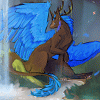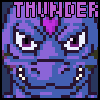
A bunch of different Lomani goblin species, and a kikimora, too (not considered a goblin, but phylogenetically right in the middle).
While their lifestyle is similar, imps and goblins aren't closely related, as the latter are closer to harpies and griffins. They're rarely bigger than 60 cm (with the exception of the kikimora, which averages on 1,1 m), are rarely beyond the subpaleolithic stage, but a number of species willingly cooperate with other sapient species in exchange for food and shelter. Unlike imps, which are mostly forest dwellers, a number of goblins adapted to live in open space, often recognizeable by the reduction or lack of vaned feathers.
Kikimoras are a rather special case. They are restricted to the conifer forests of a large mountain range in eastern Faluria (a continent comparable to Europe), have a venomous bite and the majority of individuals has the ability to sense magic (of course, they can't use it, as that is an ability restricted to dragons and their direct descendants)
While their lifestyle is similar, imps and goblins aren't closely related, as the latter are closer to harpies and griffins. They're rarely bigger than 60 cm (with the exception of the kikimora, which averages on 1,1 m), are rarely beyond the subpaleolithic stage, but a number of species willingly cooperate with other sapient species in exchange for food and shelter. Unlike imps, which are mostly forest dwellers, a number of goblins adapted to live in open space, often recognizeable by the reduction or lack of vaned feathers.
Kikimoras are a rather special case. They are restricted to the conifer forests of a large mountain range in eastern Faluria (a continent comparable to Europe), have a venomous bite and the majority of individuals has the ability to sense magic (of course, they can't use it, as that is an ability restricted to dragons and their direct descendants)
Category All / All
Species Unspecified / Any
Size 835 x 1280px
File Size 279.4 kB

 FA+
FA+











Comments